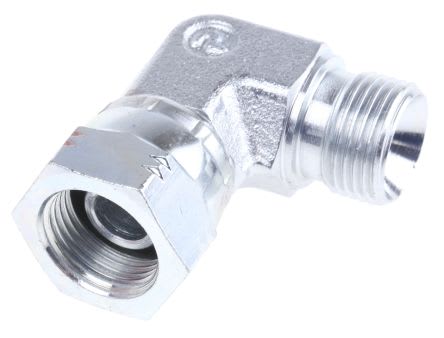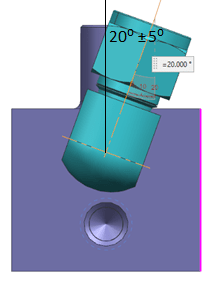F. S. Farimani
Mechanical
We have a hydraulic system with multiple elbow connectors, for example:

That connect hoses to some manifolds and other stuff. The connectors need to be installed at specific angles with certain tolerance (i.e., ±5⁰), for example:

Though, the system is not mass produced per se (let's say once a week), it needs to be rather precise. So one of our genius technicians at manufacturing department has built some molds so they can test the angles and make sure they are within the given tolerance. And by mold I mean a piece of cute sheet metal with an inclined edge, which they place under the connector. Just like that!
Now I was wondering if there is a more canonical way to handle this. These are the ideas coming to my mind:
[ul]
[li]Some form of gauged torque wrench which the user can read the angle from manually[/li]
[li]laser cutting, carving, or printing the angles onto the parts and manifolds so the user can confirm the angles visually[/li]
[/ul]
I'm interested to know your opinion. Should we just streamline the technician's idea? should we use any of the ideas above? Do you have any other ideas or maybe there are already best practices for this in industry? Thanks for your support in advance and looking forward to hearing back.

That connect hoses to some manifolds and other stuff. The connectors need to be installed at specific angles with certain tolerance (i.e., ±5⁰), for example:

Though, the system is not mass produced per se (let's say once a week), it needs to be rather precise. So one of our genius technicians at manufacturing department has built some molds so they can test the angles and make sure they are within the given tolerance. And by mold I mean a piece of cute sheet metal with an inclined edge, which they place under the connector. Just like that!
Now I was wondering if there is a more canonical way to handle this. These are the ideas coming to my mind:
[ul]
[li]Some form of gauged torque wrench which the user can read the angle from manually[/li]
[li]laser cutting, carving, or printing the angles onto the parts and manifolds so the user can confirm the angles visually[/li]
[/ul]
I'm interested to know your opinion. Should we just streamline the technician's idea? should we use any of the ideas above? Do you have any other ideas or maybe there are already best practices for this in industry? Thanks for your support in advance and looking forward to hearing back.
